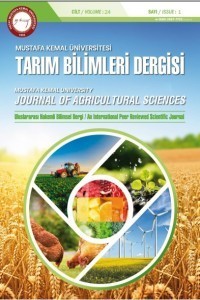Kırmızı biber [Capsicum annuum L. var. conoides (Mill.) Irish] hibritlerinde verim, toplam çözünebilir madde ve kuru madde yönünden heterosis, heterobeltiosis ve dominans etkisinin belirlenmesi
biber, heterosis, heterobeltiosis, dominans etkisi, verim
Heterosis, heterobeltiosis and dominance effect on yield, total soluble solid and dry matter of red pepper [Capsicum annuum L. var. conoides (Mill.) Irish] hybrids
pepper, heterosis, heterobeltiosis, dominance effect, yield,
___
- Abrham S, Mandefro N, Sentayehu A (2017) Heterosis and heterobeltiosis study of hot pepper (Capsicum annuum L.) genotypes in Southern Ethiopia. Int J Plant Breed, 11, 63-70.
- AlBallat IA, Ahmed ME, Ommran S, Alkadah KAG (2019) Heterosis, combining ability and heritability of fruit yield and quality traits in blocky yellow sweet pepper. Egypt. J. Plant Breed. 23(6):1267– 1297
- Andrade Junior VC, Pedrosa CE, Miranda TG, Valadares NR, Pereira SL, Azevedo AM (2018) Biometric evaluation of morpho-agronomic traits in pepper lines and hybrids. Horticultura Brasileira, 36, 357-361.
- Anonymous (2020) FAO Crops and livestock products. Retrieved February 15, 2022 from https://www.fao.org/faostat/en/#data/QCL
- Bhutia ND, Seth T, Shende VD, Dutta S, Chattopadhyay, A (2015) Estimation of heterosis, dominance effect and genetic control of fresh fruit yield, quality and leaf curl disease severity traits of chilli pepper (Capsicum annuum L.). Scientia Horticulturae, 182, 47-55.
- Chakrabarty S, Islam AKM, Mian MA, Ahamed T (2019) Combining ability and heterosis for yield and related traits in chili (L.). The Open Agriculture Journal, 13(1).
- Ferreira TAPC, Valadares KO, Souza MJF, Santana JQ, Balbino MP, Ferreira RC (2012) Yellow and red sweet pepper quality under photoselective screens and field crop conditions. In VII International Symposium on Light in Horticultural Systems 956 (pp. 473-479).
- Ganefianti DW, Fahrurrozi F (2018) Heterosis and combining ability in complete diallel cross of seven chili pepper genotypes grown in ultisol. AGRIVITA Journal of Agricultural Science, 40(2), 360–370. http://doi.org/10.17503/agrivita.v40i2.991
- Khalil MR, Hatem MK (2014) Study on combining ability and heterosis of yield and its components in pepper (Capsicum annum L.). Alex. J. Agric. Res, 59(1), 61-71.
- Kumar S, Kumar R, Kumar D, Gautam N, Singh N, Parkash C, Shukla YR (2017) Heterotic potential, potence ratio, combining ability and genetic control of yield and its contributing traits in cucumber (Cucumis sativus L.). New Zealand Journal of Crop and Horticultural Science, 45(3), 175-190.
- Naves ER, Scossa F, Araújo WL, Nunes-Nesi A, Fernie AR, Zsögön A (2022) Heterosis and reciprocal effects for agronomic and fruit traits in Capsicum pepper hybrids. Scientia Horticulturae, 295, 110821.
- Pérez-Grajales M, González-Hernández VA, Peña-Lomelí A, Sahagún-Castellanos J (2009) Combining ability and heterosis for fruit yield and quality in manzano hot pepper (Capsicum pubescens R & P) landraces. Revista Chapingo. Serie horticultura, 15(1), 103-109.
- Rao PG, Reddy KM (2017) Exploitation of mid parent heterosis in bell pepper (Capsicum annuum L.) for yield and yield attributing traits. Agricultural Research Journal, 54(1), 117-119.
- Rodrigues R, Gonçalves LS, Bento CDS, Sudré CP, Robaina RR, do Amaral Júnior AT (2012) Combining ability and heterosis for agronomic traits in chili pepper. Horticultura Brasileira, 30, 226-233.
- Rohini N, Lakshmanan V (2017) Heterotic expression for dry pod yield and its components in chilli (Capsicum annuum var. annuum). JAPS: Journal of Animal & Plant Sciences, 27(1).
- Sahid ZD, Syukur M, Maharijaya A (2020) Combining ability and heterotic effects of chili pepper (Capsicum annuum L.) genotypes for yield components and capsaicin content. SABRAO J Breeding and Genetics, 52(4), 390-401.
- Shrestha SL, Luitel BP, Kang WH (2011) Heterosis and heterobeltiosis studies in sweet pepper (Capsicum annuum L.). Horticulture, Environment, and Biotechnology, 52(3), 278-283.
- Singh P, Cheema DS, Dhaliwal MS, Garg N, Jindal SK, Chawla N (2015) Combining ability and heterosis for quality and processing traits in chili pepper (Capsicum annuum L.) involving male sterile lines. Journal of Crop Improvement, 29(4), 379-404.
- Soames I, Cıulca A, Madosa E, Cıulca S (2021) Estimation of Heterosis and Potence Ratio for Plant Yield in Hot Pepper. Life Science and Sustainable Development, 2(2), 82-87.
- Yilmaz N, Sari N (2012) Heterosis effect on plant growth fruit, yield and quality in single, triple and double crosses of melon (Cucumis melo var. cantalupensis) Hybrids. In Yilmaz N, Sari N, editors. Proceeding of the Xth EUCARPIA Meeting on Genetics and Breeding of Cucurbitaceae (pp. 535-543).
- Yayın Aralığı: Yılda 3 Sayı
- Başlangıç: 1996
- Yayıncı: Hatay Mustafa Kemal Üniversitesi
Onur Sefa ALKAÇ, Sabriye BELGÜZAR, Esra ÖNDEŞ, Fulya OKATAR, Zeliha KAYAASLAN
Nijerya’da sebze üretiminin kırsal hanelerin gelir ve geçim kaynakları üzerindeki etkileri
Ridwan MUKAİLA, Abraham FALOLA, Sheu-usman Oladipo AKANBİ, Lynda EGWUE, Angela OBETTA, Tochukwu Linda ONAH
Bazı yabancı badem çeşitlerinin Gaziantep ekolojisindeki verim ve meyve özellikleri
Cin mısırının (Zea mays everta Sturt.) bazı kalite özelliklerine sulamanın etkisi
Cem Tufan AKÇALI, Cenk Burak ŞAHİN
Aysun UYSAL, Şener KURT, Soner SOYLU, Merve KARA, Emine Mine SOYLU
Yerel fasulye (Phaseolus vulgaris L.) genotiplerinin agro-morfolojik karakterizasyonu
İbrahim ERTEKİN, Şaban YILMAZ, Ersin CAN
Senay MURAT DOĞRU, Hayati KAR, Mehtap ÖZBAKIR ÖZER, Nur KOBAL BEKAR
